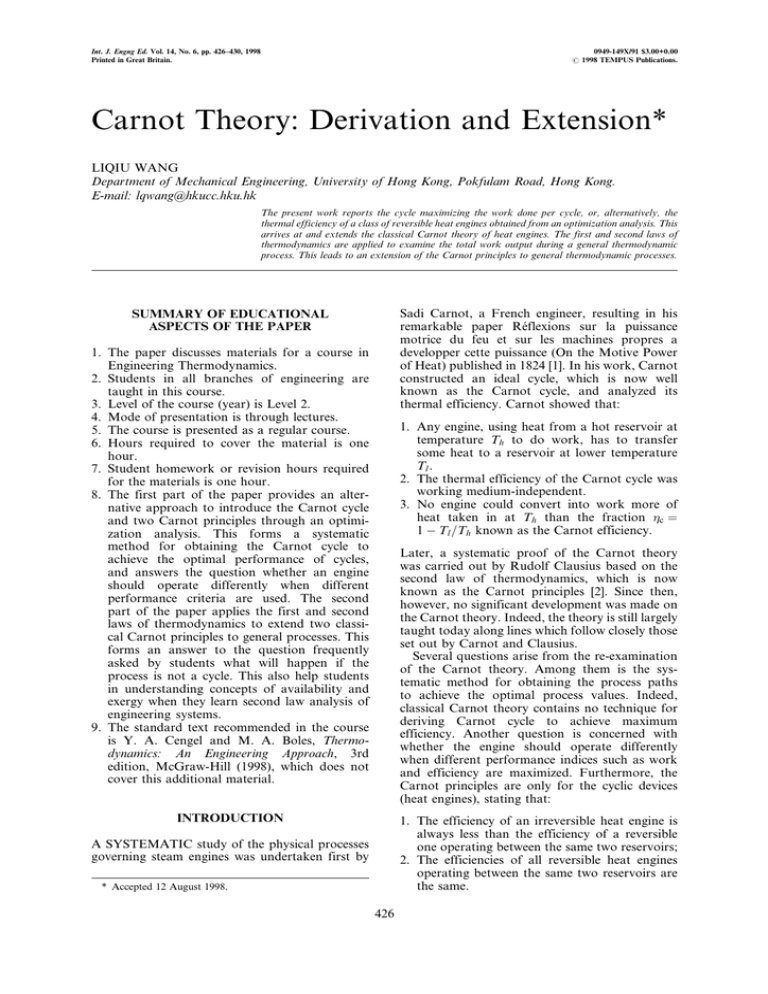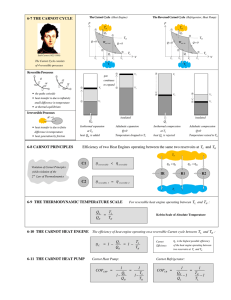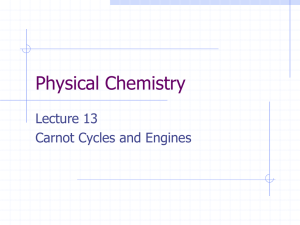Carnot Theory: Derivation and Extension*
advertisement

Int. J. Engng Ed. Vol. 14, No. 6, pp. 426±430, 1998 Printed in Great Britain. 0949-149X/91 $3.00+0.00 # 1998 TEMPUS Publications. Carnot Theory: Derivation and Extension* LIQIU WANG Department of Mechanical Engineering, University of Hong Kong, Pokfulam Road, Hong Kong. E-mail: lqwang@hkucc.hku.hk The present work reports the cycle maximizing the work done per cycle, or, alternatively, the thermal efficiency of a class of reversible heat engines obtained from an optimization analysis. This arrives at and extends the classical Carnot theory of heat engines. The first and second laws of thermodynamics are applied to examine the total work output during a general thermodynamic process. This leads to an extension of the Carnot principles to general thermodynamic processes. Sadi Carnot, a French engineer, resulting in his remarkable paper ReÂflexions sur la puissance motrice du feu et sur les machines propres a developper cette puissance (On the Motive Power of Heat) published in 1824 [1]. In his work, Carnot constructed an ideal cycle, which is now well known as the Carnot cycle, and analyzed its thermal efficiency. Carnot showed that: SUMMARY OF EDUCATIONAL ASPECTS OF THE PAPER 1. The paper discusses materials for a course in Engineering Thermodynamics. 2. Students in all branches of engineering are taught in this course. 3. Level of the course (year) is Level 2. 4. Mode of presentation is through lectures. 5. The course is presented as a regular course. 6. Hours required to cover the material is one hour. 7. Student homework or revision hours required for the materials is one hour. 8. The first part of the paper provides an alternative approach to introduce the Carnot cycle and two Carnot principles through an optimization analysis. This forms a systematic method for obtaining the Carnot cycle to achieve the optimal performance of cycles, and answers the question whether an engine should operate differently when different performance criteria are used. The second part of the paper applies the first and second laws of thermodynamics to extend two classical Carnot principles to general processes. This forms an answer to the question frequently asked by students what will happen if the process is not a cycle. This also help students in understanding concepts of availability and exergy when they learn second law analysis of engineering systems. 9. The standard text recommended in the course is Y. A. Cengel and M. A. Boles, Thermodynamics: An Engineering Approach, 3rd edition, McGraw-Hill (1998), which does not cover this additional material. 1. Any engine, using heat from a hot reservoir at temperature Th to do work, has to transfer some heat to a reservoir at lower temperature Tl . 2. The thermal efficiency of the Carnot cycle was working medium-independent. 3. No engine could convert into work more of heat taken in at Th than the fraction c 1 ÿ Tl =Th known as the Carnot efficiency. Later, a systematic proof of the Carnot theory was carried out by Rudolf Clausius based on the second law of thermodynamics, which is now known as the Carnot principles [2]. Since then, however, no significant development was made on the Carnot theory. Indeed, the theory is still largely taught today along lines which follow closely those set out by Carnot and Clausius. Several questions arise from the re-examination of the Carnot theory. Among them is the systematic method for obtaining the process paths to achieve the optimal process values. Indeed, classical Carnot theory contains no technique for deriving Carnot cycle to achieve maximum efficiency. Another question is concerned with whether the engine should operate differently when different performance indices such as work and efficiency are maximized. Furthermore, the Carnot principles are only for the cyclic devices (heat engines), stating that: INTRODUCTION 1. The efficiency of an irreversible heat engine is always less than the efficiency of a reversible one operating between the same two reservoirs; 2. The efficiencies of all reversible heat engines operating between the same two reservoirs are the same. A SYSTEMATIC study of the physical processes governing steam engines was undertaken first by * Accepted 12 August 1998. 426 Carnot Theory: Derivation and Extension The questions regarding the performances of a general thermodynamic process have been left unanswered. The motivation for the present work comes from the desire of deriving the Carnot theory in a systematic and rigorous way and extending the Carnot theory to answer questions mentioned above. This yields a systematic technique to find the optimal cycle and an extension of the Carnot principles to the general thermodynamic processes. The present work is believed to be of both pedagogical and academic importance by noting that the classical Carnot theory is only on analyzing the performances of the Carnot cycle with known process paths rather than deriving the cycle to achieve the optimal performances. Maximum work By applying the first law of thermodynamics to the cycle, the work done per cycle may be written as: W T S dS 4 Therefore we should maximize W subject to the constraint (1), i.e., we maximize: L W ÿ S T S ÿ dS 5 by varying T S . In order to take account of constrains (2) and (3), we replace T and S by two new variational parameters and such that DERIVATION AND EXTENSION: CYCLES Heat engines may be conveniently classified by the type of cycle undergone by the working fluid. For the engines considered in this work, such cycles are made up of totally reversible processes in which working fluid undergoes reversible transformations (internal reversibility) and is coupled to the environment through reversible processes (external reversibility) [2, 3]. They are reversible engines discussed in thermodynamic textbooks. For a cycle, S dS 0 1 Here S is the change of the working fluid in entropy. In the present work we choose entropy as the independent variable and temperature as the dependent variable. Then the property of the working fluid is represented by the function relation T T S . Let Th and Tl be the temperature of the hottest and coldest thermal reservoirs, then the function T T S must satisfy: Tl T Th 2 Furthermore, we require: Si S Sm 3 where Si and Sm are the minimum and maximum values of entropy permitted during the cycle, respectively. Following analyses are to find function T T S which makes the work done, thermal efficiency or whatever else we choose as an objective functional an extreme. In this paper, we investigate the optimal operation of engines in terms of maximum work and maximum efficiency as follows. 427 T 12 Th Tl 12 Th ÿ Tl tanh 6 S 12 Sm Si 12 Sm ÿ Si tanh 7 where and are unconstrained. It is now a simple matter to maximize L by applying Euler-Lagrange equation as: 1 4 Th ÿ Tl Sm ÿ Si sech2 sech2 0 8 This leads to: 1 9 1 10 T Th or Tl 11 S Si or Sm 12 or which mean that: and Therefore, optimal trajectory is made up of four branches: T S Th 13 T S Tl 14 S Si 15 S Sm 16 It is a simple matter to prove that the Legendre's necessary condition [4] is also satisfied along each of these branches. The resultant optimal cycle is shown in Fig. 1. At corners 1±4, it is simple to show that both first and second WeierstrassErdmaun corner conditions [4] are satisfied. In order to show that this is the true maximum, it is usually to consider second variation of L. If the second variation is less than zero for all admissible functions in a particular one-parameter family, the result is regarded as the true maximum. However, this is fallacious as pointed out in [4]. It is only the necessary condition for the maximum 428 L. Wang Proof. Since: J3 J1 =J2 , then: that the first variation is zero and second variation is less than zero. Readers are referred to [4] for this. In the best knowledge of the author, the general sufficient conditions have not been established in the calculus of variations. An ad hoc proof is usually produced for some problems. Fortunately, the second law of thermodynamics concludes that the solution obtained is really a maximum for our problem. Under optimal trajectory, the maximum work is: Using the notation 0 J1 ye =J2 ye , we obtain: Wmax Th ÿ Tl Sm ÿ Si J1 ÿ 0 J2 J1 ÿ 0 J2 Here 18 Q1 T S dS dS 19 is the input energy with dS as the Heaviside step function [ x 1 if x > 0, x 1 if x < 0]. It is worth noting that is constant once Tl and Th are fixed. However, Wmax increases proportionally with Sm ÿ Si . The cycle derived above is the Carnot cycle operating between Th and Tl . It is worth to note that the fact that we need only the hottest and coldest reservoirs and that we do not need any other reservoirs is not a trivial result. Also, the derivation does not depend on the working medium. Maximum efficiency It is often useful to run an engine at maximum efficiency rather than some other operating goal such as we did above. The efficiency is, as usual, defined by: W =Q1 Suppose that y ye x yields the extreme of the functional J3 . Then J3 0, and therefore (if J2 6 0): J2 ye J1 ÿ J1 ye J2 0 17 and the efficiency is: Wmax =Q1 1 ÿ Tl =Th J3 J2 J1 ÿ J1 J2 =J22 20 where W and Q1 are defined by equations (4) and (19), respectively. This is a quotient of two integrals. There are two ways to obtain its optimal trajectory. One is to maximize for a fixed input energy Q1 . If the resulted maximum value of is dependent on Q1 , the optimization of with respect to Q1 is followed to achieve the final result. The other is to maximize directly based on the following theorem. and we arrive at the theorem above. For our problem, two methods lead to the same result. Shown in this paper is the second method. Applying Theorem 1 to our problem, maximizing in equation (20) under constraint (1), is the same as maximizing: L W ÿ S ÿ 0 Q1 It is simple to show that we again obtain the Carnot cycle as shown in Fig. 1 with: max 1 ÿ Tl =Th 25 W Th ÿ Tl Sm ÿ Si 26 and These are the same as those in equations (17) and (18). Once again, the Legendre's necessary condition and both first and second Weierstrass-Erdmaun corner conditions are satisfied by the solution. Also the second law of thermodynamics concludes that this is a true maximum. The optimal process paths can also be regarded as the representation of the property of the optimal working fluid. This shifts the focus from the process to the working fluid. The optimal path 2±3 in Fig. 1, for example, may be realized not only through an isothermal process but also through any working fluid with the property of entropy-independent temperature. Boiling water under the constant pressure has this property. Then the boiling water may be used to realize this path under the constant pressure. Theorem 1. The function yielding the extreme of the quotient of two functionals J1 and J2 should satisfy the Euler-Lagrange equation for the intermediate functional: H J1 ÿ 0 J2 21 The constant 0 is determined from the condition: 0 J1 ye =J2 ye 22 where y ye yields the extreme of the functional: J3 J1 =J2 23 24 Fig. 1. Optimal cycle of reversible heat engines. Carnot Theory: Derivation and Extension 429 EXTENSION: PROCESSES Consider a mass system A undergoing a process from state 1 to state 2 in Fig. 2. The work directly delivered by the system is termed the internal work Wi12 . The work produced by auxiliary is called external work ÿ Pcyclic devices We12 in 1 Wei12 . Such auxiliary cyclic devices are required to ensure external reversibility [2, 3] in any heat exchanges between the system and its environment for a general process 1±2. The sum of Wi12 and We12 is termed total work Wt12 . Note that the process in the auxiliary devices is cyclic. The change in the total energy of the combined system A , comprising A and the auxiliary cyclic devices, is thus equal toÿthat the system A alone. The P for n 12 Wt12 and Q12 Q are the work and i 1 0i 0 heat interactions between the system A and its surroundings, respectively. A striking feature of Wt12 can be revealed by applying both first and second laws of thermodynamics to the system A , and is summarized as the following theorem which can be regarded as an extension of the Carnot principles to the general processes. Theorem 2. For a system exchanging heat with a single thermal reservoir (the environment at temperature T0 for example), the total work output is the same for all totally reversible processes between the same specified end states 1 and 2, which is termed the maximum total work 12 symbolized with WtR . During any irreversible process between these same specified end states, 12 the total work output WtI12 is always less than WtR . Proof. To prove this theorem, consider two processes R and I between 1 and 2, as shown in Fig. 3(a). One process (R) is totally reversible, and the other (I ) is irreversible. The amount of total work produced during the totally reversible pro12 cess R is WtR , and the amount produced during the irreversible one is WtI12 . The heat exchanged with the environment during the totally reversible process R is Q12 0R , and the heat to the environment during the irreversible one I is Q12 0I . In violation of the theorem, we assume that Fig. 3. Proof of theorem 2. 12 12 WtI12 > WtR and thus Q12 0I < Q0R by the first law of thermodynamics. Now let the reversible process be reversed as a process R0 from 2 to 1. This process 12 will receive a work input WtR from the surroundings 12 and a heat input Q0R from the environment. Now considering the R0 and I together as a cycle (Fig. 3(b)), we have an engine that produces a 12 net work in the amount of WtI12 ÿ WtR while exchanging heat with a single reservoir in the 12 amount of Q12 0R ÿ Q0I , which is a violation of the Kelvin-Planck statement of the second law of thermodynamics. Therefore we conclude that: 12 WtI12 WtR 27 However, if the equality holds in equation (27), the process I must be reversible as the process R 0 could then also act as the erasing process of I. This is certainly against the initial assumption. Consequently, we have: 12 WtI12 < WtR 28 Since both processes R and I are arbitrarily chosen as the totally reversible and irreversible respectively, this is the proof that the total work output during an irreversible process is always less than that during a totally reversible process. Now we replace I and R by two arbitrarily chosen totally reversible processes R1 and R2 12 12 respectively. Equation (27) leads to WtR WtR . 1 2 Similarly, if I and R are replaced by R2 and R1 12 12 respectively, equation (27) yields WtR WtR . 2 1 As both expressions are true, to satisfy them simultaneously, we must have: 12 12 WtR : WtR 1 2 However, R1 and R2 are any two totally reversible processes between the specified end states 1 and 2, so that we conclude: 12 12 12 WtR WtR WtR 1 2 Fig. 2. Total work and totally reversible process. 29 This and equation (28) together establish the above-stated theorem. While work is generally dependent on the characteristics of process, 12 WtR is uniquely-valued for all totally reversible 430 L. Wang processes between two specified end states 1 and 2. Therefore, it must represent the change of a state property. It should be noted that the theorem is not valid for the internal work output as, with variable temperature of the system A, we cannot find a single thermal reservoir to ensure the reversible heat transfer. CONCLUSIONS The optimization theory is used to derive and extend the classical Carnot theory. Two performance indices, work done per cycle and thermal efficiency, are used in the process of optimization. Same results are obtained for these two performance indices. This shows that the operation of the engines considered in this work should remain unchanged when different performance indices are optimized. The optimization analysis for reversible heat engines arrives at the Carnot theory of heat engines. Unlike the classical thermodynamics, the new approach provides methods for deriving the Carnot cycle to achieve maximum work or efficiency. The first and second laws of thermodynamics are employed to show that: (1) the total work output during any irreversible process is always less than that during a totally reversible one between the same specified end states, and (2) the total work output is the same for all totally reversible processes between the same specified end states. This may be regarded as the extension of the Carnot principles to the general processes. REFERENCES 1. S. Carnot, Reflections on the Motive Power of Fire, ed. E. Mendoza, Gloucester Mass Peter Smith Pub. (1977). 2. Y. A. Cengel and M. A. Boles, Thermodynamics (3rd Edition), McGraw-Hill, New York (1998). 3. G. J. Van Wylen, R. E. Sonntag and C. Borgnakke, Fundamentals of Classical Thermodynamics, Wiley, New York (1994). 4. L. A. Pars, An Introduction to the Calculus of Variations, Heinemann, London (1962). L. Wang is currently an associate professor in the Department of Mechanical Engineering, University of Hong Kong. He received his PhD from University of Alberta, Canada in 1995. He has published over 60 technical articles in leading international journals and conference proceedings. His research interests cover both fundamental principles and engineering applications by analytical, numerical and experimental approaches in the areas of applied mathematics, thermal sciences, energy and power engineering. Currently, his research focuses on multi-scale transport phenomena, flow instability and bifurcation, and microscale transport phenomena.






